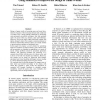Free Online Productivity Tools
i2Speak
i2Symbol
i2OCR
iTex2Img
iWeb2Print
iWeb2Shot
i2Type
iPdf2Split
iPdf2Merge
i2Bopomofo
i2Arabic
i2Style
i2Image
i2PDF
iLatex2Rtf
Sci2ools
AIIDE
2009
2009
Using Semantics to Improve the Design of Game Worlds
Design of game worlds is becoming more and more laborintensive because of the increasing demand and complexity of content. This is being partially addressed by developing semi-automated procedural techniques that help generate (parts of) game worlds (e.g terrains, cities and buildings). However, most level editors rather deficiently capture and deploy designer's intent. For example, common positional or functional relationships between objects are usually limited to pre-processing a number of anticipated cases. In this paper we propose a novel scheme for specifying high-level semantics of objects within a game virtual world, and in particular we illustrate its application to a variety of layout solving problems raised by procedural generation methods. Our approach combines the genericity of a semantic class library with the power of a layout solver, and it shows to be both very flexible and effective. Moreover, this scheme can be useful for improving both manual, automated and mi...
AIIDE 2009 | Artificial Intelligence | Deploy Designer Intent | Game World | Semi-automated Procedural Techniques |
| Added | 08 Nov 2010 |
| Updated | 08 Nov 2010 |
| Type | Conference |
| Year | 2009 |
| Where | AIIDE |
| Authors | Tim Tutenel, Ruben Michaël Smelik, Rafael Bidarra, Klaas Jan de Kraker |
Comments (0)

